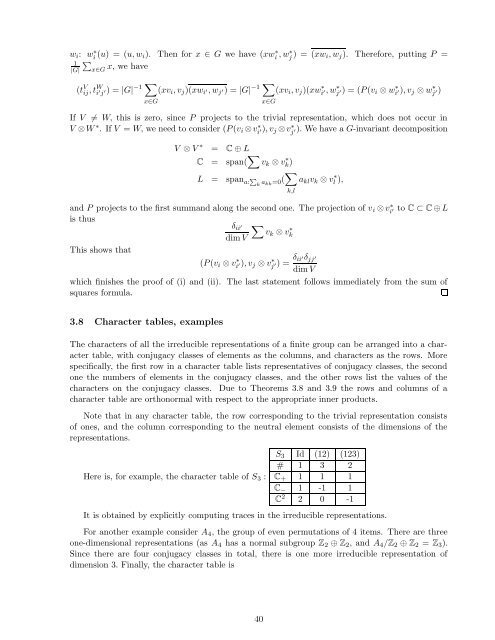Lecture notes for Introduction to Representation Theory
Lecture notes for Introduction to Representation Theory
Lecture notes for Introduction to Representation Theory
Create successful ePaper yourself
Turn your PDF publications into a flip-book with our unique Google optimized e-Paper software.
w i : w ⊕ i (u) = (u, w i ). Then <strong>for</strong> x G we have (xw ⊕ i , w ⊕ j ) = (xw i , w j ). There<strong>for</strong>e, putting P =<br />
1<br />
⎨<br />
x, we have<br />
|G|<br />
V<br />
xG<br />
W<br />
(t ij , t i ⊗ j ⊗ ) = |G|−1 (xv i , v j )(xw i ⊗ , w j ⊗ ) = |G| −1 (xv i , v j )(xw i<br />
⊕ ⊗ , w j<br />
⊕ ⊗ ) = (P (v i w i<br />
⊕ ⊗ ), v j w j<br />
⊕ ⊗ )<br />
xG<br />
If V = ⇒ W, this is zero, since P projects <strong>to</strong> the trivial representation, which does not occur in<br />
V W ⊕ . If V = W, we need <strong>to</strong> consider (P (v i v⊕ i⊗ ), v j v⊕ j⊗ ). We have a G-invariant decomposition<br />
V V ⊕<br />
=<br />
C L<br />
xG<br />
C = span( v k v k ⊕ )<br />
L = span<br />
P a: k a kk =0( a kl v k v ⊕ l ),<br />
and P projects <strong>to</strong> the first summand along the second one. The projection of v i v⊕ i⊗ <strong>to</strong> C → C L<br />
is thus<br />
ζ ii ⊗<br />
<br />
⊕ vk v<br />
dim V<br />
k<br />
This shows that<br />
⊕ ⊕<br />
(P (v i v i⊗ ), v j v j⊗ ) = ζ ii ⊗ ζ jj ⊗<br />
dim V<br />
which finishes the proof of (i) and (ii). The last statement follows immediately from the sum of<br />
squares <strong>for</strong>mula.<br />
k,l<br />
3.8 Character tables, examples<br />
The characters of all the irreducible representations of a finite group can be arranged in<strong>to</strong> a character<br />
table, with conjugacy classes of elements as the columns, and characters as the rows. More<br />
specifically, the first row in a character table lists representatives of conjugacy classes, the second<br />
one the numbers of elements in the conjugacy classes, and the other rows list the values of the<br />
characters on the conjugacy classes. Due <strong>to</strong> Theorems 3.8 and 3.9 the rows and columns of a<br />
character table are orthonormal with respect <strong>to</strong> the appropriate inner products.<br />
Note that in any character table, the row corresponding <strong>to</strong> the trivial representation consists<br />
of ones, and the column corresponding <strong>to</strong> the neutral element consists of the dimensions of the<br />
representations.<br />
S 3 Id (12) (123)<br />
# 1 3 2<br />
Here is, <strong>for</strong> example, the character table of S 3 : C + 1 1 1<br />
C−<br />
1 -1 1<br />
C 2 2 0 -1<br />
It is obtained by explicitly computing traces in the irreducible representations.<br />
For another example consider A 4 , the group of even permutations of 4 items. There are three<br />
one-dimensional representations (as A 4 has a normal subgroup Z 2 Z 2 , and A 4 /Z 2 Z 2 = Z 3 ).<br />
Since there are four conjugacy classes in <strong>to</strong>tal, there is one more irreducible representation of<br />
dimension 3. Finally, the character table is<br />
40

















